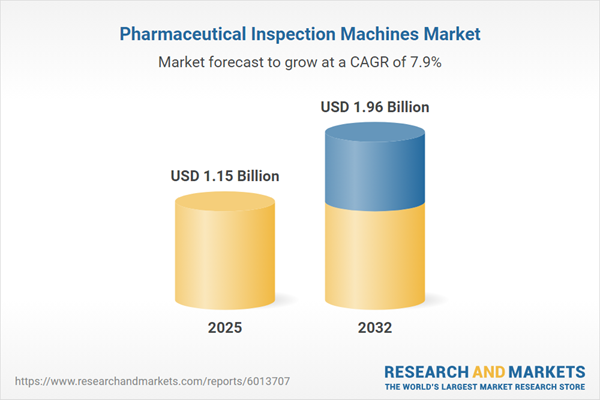Speak directly to the analyst to clarify any post sales queries you may have.
Senior pharmaceutical executives are navigating a rapidly evolving landscape, where rising quality demands and technological advancements in inspection machines have become essential for ensuring compliance and operational resilience. The pharmaceutical inspection machines market is defined by the need for intelligent, automated solutions capable of supporting global-scale production and quality assurance strategies.
Market Snapshot: Pharmaceutical Inspection Machines Market Trends
The pharmaceutical inspection machines market continues to demonstrate strong growth, supported by ongoing advancements in automation and artificial intelligence. Forward-looking industry leaders are leveraging next-generation inspection solutions to address complex supply chain challenges and streamline both packaging and quality control. As regulatory standards become increasingly stringent, prioritizing predictive and technology-driven assurance methods is vital for meeting elevated global quality benchmarks. This ongoing shift is altering competitive dynamics and equipping organizations to respond rapidly to shifting compliance and operational challenges.
Scope & Segmentation of the Pharmaceutical Inspection Machinery Market
- Machine Types: Label verification systems designed for barcode validation and print quality assessment; leak testing modules that utilize mass extraction and vacuum technologies; seal, weight, and visual inspection units suitable for both automated and manual quality checks across different product formats.
- Packaging Types: Systems compatible with ampoules, glass or plastic bottles, vials, prefilled and empty syringes, as well as flexible pouches, supporting high-volume production and specialized batch manufacturing.
- Technologies: Integration of deep learning and artificial intelligence enhances the detection of defects, and hybrid inspection systems combine automation with human oversight to address the distinct regulatory and product needs of the sector.
- Automation Levels: Fully automated inspection solutions increase throughput and reduce manual intervention, while semi-automatic models provide adaptable options for facilities requiring flexibility during production.
- End Users: Utilized by biotechnology companies, pharmaceutical manufacturers, contract service organizations, and research institutes for driving compliance and simplifying complex operational processes.
- Geographies: Broad adoption across the Americas (United States, Canada, Brazil, Latin America), Europe, the Middle East, Africa, and Asia-Pacific regions such as China, India, Japan, and Southeast Asia, driven by modernization and regulatory initiatives.
Key Takeaways for Senior Decision-Makers
- Artificial intelligence in inspection systems allows earlier identification of issues, facilitating adaptation to evolving regulatory frameworks while improving reliability of defect management strategies.
- Imaging technologies with data-enabled capabilities can seamlessly integrate into both established and modern production environments, ensuring that upgrades support consistent quality outcomes without major disruption.
- Combining advanced inspection machinery with expert teams strengthens process dependability, critical for overseeing established product lines and supporting innovation in therapeutic development.
- Robust supplier partnerships reinforce sourcing strategies and help create resilient supply chains that can withstand fluctuating global and market conditions.
- Engagement with robotics, sensing, and analytics experts enables continuous improvement initiatives and protects ongoing capital investments, ensuring processes remain current as inspection technologies advance.
Tariff Impact on Pharmaceutical Inspection Equipment
Recent implementation of US tariffs on imported sensors and electronics is prompting a reassessment of sourcing and cost-optimization strategies in the pharmaceutical inspection machines market. As a response, equipment manufacturers are strengthening relationships with domestic suppliers and investing in engineering initiatives that deliver enduring value. This shift is encouraging renewed investment in local capacity, fostering innovation and helping the sector manage global trade changes more effectively.
Methodology & Data Sources
This market assessment is grounded in a thorough analysis of industry publications, third-party technology reports, and key regulatory documentation. Insights have also been gathered from experienced executives and leading equipment vendors, ensuring recommendations are tailored to the concerns of senior decision-makers.
Why This Report Matters to Senior Leaders
- Enables effective evaluation of inspection workflows and supports procurement choices by providing a comprehensive segmentation analysis.
- Prepares organizations to anticipate developments in automation, compliance requirements, and global supply chain dynamics for sustained market competitiveness.
- Offers a practical approach to assessing investments in inspection systems and maintaining continuous quality management in compliance-focused environments.
Conclusion
Adopting advanced pharmaceutical inspection machines is fundamental for maintaining quality control and regulatory compliance in a dynamic industry. Selecting adaptable, innovative systems positions organizations to meet ongoing challenges and enhance long-term success.
Additional Product Information:
- Purchase of this report includes 1 year online access with quarterly updates.
- This report can be updated on request. Please contact our Customer Experience team using the Ask a Question widget on our website.
Table of Contents
3. Executive Summary
4. Market Overview
7. Cumulative Impact of Artificial Intelligence 2025
Companies Mentioned
The companies profiled in this Pharmaceutical Inspection Machines market report include:- Mettler-Toledo International Inc.
- Thermo Fisher Scientific Inc.
- Sartorius AG
- Syntegon Technology GmbH
- Krones AG
- Ishida Co., Ltd.
- ProMach, Inc.
- Coesia S.p.A.
- Seidenader Maschinenbau GmbH
- Loma Systems Ltd.
Table Information
| Report Attribute | Details |
|---|---|
| No. of Pages | 184 |
| Published | October 2025 |
| Forecast Period | 2025 - 2032 |
| Estimated Market Value ( USD | $ 1.15 Billion |
| Forecasted Market Value ( USD | $ 1.96 Billion |
| Compound Annual Growth Rate | 7.9% |
| Regions Covered | Global |
| No. of Companies Mentioned | 11 |









